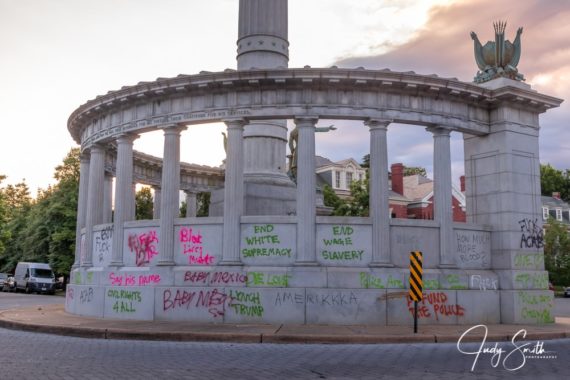In an effort to be unique, a new ubiquity has consumed Christmas decorations across the nation – inflatable snowmen glow in every front yard, multicolored neon lights clash dramatically at property lines, and Santa’s feet stick upright out of chimneys. In stark defiance to this trend, the city of Winston-Salem, with its demure Christmas decorations, features prominently in Southern Living and Our State articles and Christmas travel advice.
What makes Christmas in Winston-Salem unique is its resistance to the moving trends in Christmas decorations and its adherence to local tradition. Hanging from the porches over many front doors, atop the Baptist hospital, and on every lamppost downtown is the city’s official Christmas decoration – the Moravian star, which can be seen in the thousands across the city. This eighteen-pointed star originates from a geometry lesson in Sunday school in eastern Germany, from where the earliest settlers of the county hail, and represents the Star of Bethlehem, calling back to the first Christmas.
The center the point from which the rays of Moravian history emanate throughout the county is Old Salem, a preserved colonial settlement and living-history district. In Old Salem, as Southern Living notes, one would be hard-pressed to find a Christmas tree; rather, simple evergreen garlands and wreaths compliment lighted Moravian stars to calmly proclaim that Christmastime is here. Old Salem’s popularity, especially at Christmas, demonstrates the appeal of classic, harmonious, and historically-rooted Christmas traditions.


The historical roots of today’s Christmas decorations shine an important light on their appeal today. The Moravians were the first people to celebrate Christmas in the western Piedmont. In the early years of the American colonists, Christmas was not so widely celebrated; in fact, in Massachusetts, the Puritans banned celebrations of Christmas for an entire generation for fear that the holiday was too Catholic. In the South, while Anglicans and others celebrated Christmas mildly in the east, the Scotch-Irish of the Piedmont were more focused on simply surviving and thus thought little of the holiday. In contrast to both groups, the Moravians, with their communally-pooled resources were more well-established in the backcountry of Carolina, and their enthusiastic celebration of Christmas, then, just as now, shone out like a beacon announcing the birth of Christ to the western part of the state.
To truly understand the appeal of the Christmas traditions in Winston-Salem, it is necessary to look all the way back to 1760. As the French and Indian War raged, fears of Indian attacks in the western Piedmont spread, and in North Carolina, the westernmost military fort was Fort Dobbs, nearly 50 miles away from Forsyth County, too far to provide safety for the Scotch-Irish settlers along the Yadkin River. As such, many of these settlers found their way to Bethabara, a palisaded Moravian settlement, where they were offered safety in the event of an attack and employment at the mill. At this time, a cultural hallmark was born. The Moravians, enthusiastic to share their Christmas traditions, invited the children of the Scotch-Irish to their Christmas celebrations. The Records of the Moravians in North Carolina read as follows:
December 25, 1760: “On Christmas Day the English children from the mill came to see our Christmas decoration, they were so poorly clad that it would have moved a stone to pity. We told them why we rejoiced like children and gave to each a piece of cake. In Bethania, Brother Ettwein held a Lovefeast for the 24 children there, at the close of the service each received a pretty Christmas verse and a ginger cake, the first they had ever seen.”
In this short entry, three trends were set that 264 years later still define Christmas in Winston-Salem. First, the Moravians show off their Christmas decoration that excites people across the region – the Moravian star. Second, the people unite for a Lovefeast, a Moravian religious celebration involving song and prayer in which coffee and cakes are eaten. Third, non-Moravians join the Moravians to celebrate Christmas with festivity and joy. These three things still define Christmas in Winston-Salem as countless Moravian stars shine, people celebrate Christmas Lovefeast with Moravian baked goods, and all of it points towards the historical roots of Christmas.
Just as in 1760, people today still flock to Old Salem to see the Christmas decorations, not for over-the-top light shows, but for its aesthetic cohesion and understated beauty that, unlike inflatable snowmen, reminds us of the events at Bethlehem and our own history.






